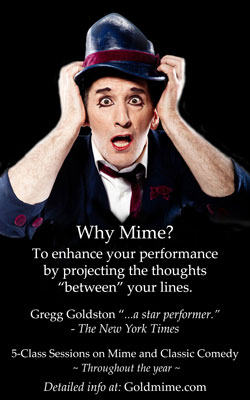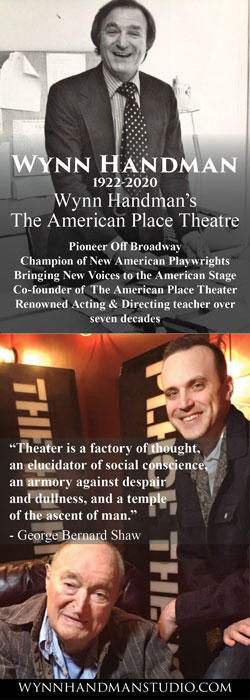The “Real” Illusion of Mime
When an audience left the theatre after a performance by Marcel Marceau, they would marvel about the world of invisible illusions he created. However, no one even realized that for two hours, this actor who performed without a word, conveyed every thought he had, or words his characters would have been speaking.
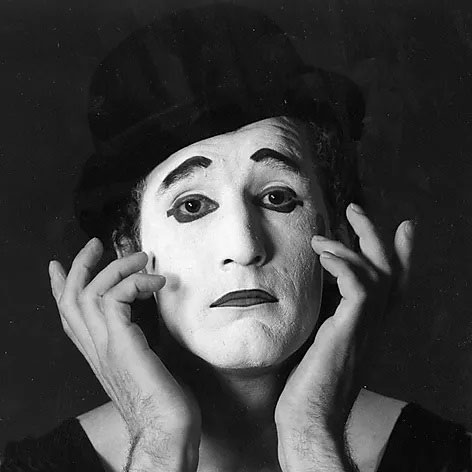
Gregg Goldston
For me, this is not the most powerful element of the art of mime. The real power is that the audience doesn’t even realize it.
A mime artist learns a non-verbal grammar system, in a similar way an actor learns to annunciate sentences in a way the public hears as natural. I’m using this comparison to say that what the mime learns, is how to ‘visually annunciate’ non-verbal thoughts.
Furthermore, to then learn a type of sentence structure that can be delivered through physical and facial gestures. This technique is seen by the public as a series of stylized poses, or more clearly said, a series of ‘rapid fire’ photographic images.
I realize this all sounds quite technical, but what this does is enable a performer to visually show an inner monologue word by word, and sentence by sentence, as opposed to just a physical emotional state.
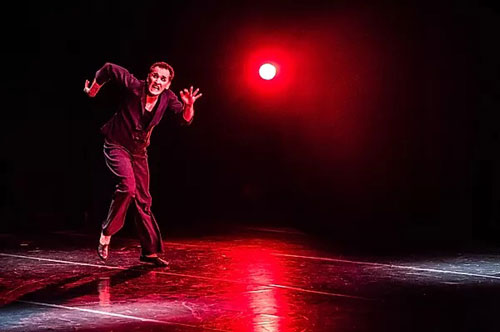
Gregg Goldston in performance
For the actor, it enables them to clearly show an audience ‘the thoughts between the words’ and the sentences of a script. It also lets a supporting actor project everything they are thinking while listening to the main actor.
Gregg Goldston in performance
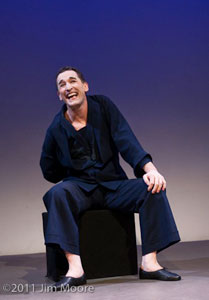
We call this the ‘real illusion’ of mime. We create the illusion of speaking, without moving our mouth. What makes mime so powerful isn’t that we are touching something invisible; it’s that we are showing what we are thinking about that thing we are touching.
As a teacher, I not only give this grammar system when I’m teaching mimes, but also to actors, stand-up comedians and even singers that I coach. When I see them apply it to their script, jokes or songs, it’s surprising how multi-layered the material becomes.
As for my own work in regard to the future of mime, I believe that the more mime feels like he is perhaps inside a film, the stronger it will move the public. Already my colleagues and I have developed ways to cross-fade from one location to another, create a slow-motion memory, ‘zooming in’ from a helicopter shot to a close-up view.
Gregg Goldston in performance
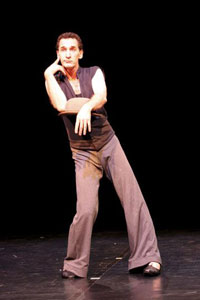
For me, mime is ‘a film’ that has been adapted for stage.
Currently, I have created a two-hour performance: “Sonatas of Love,” taking full advantage of this ‘film on stage’ concept. As we watch a quintet of classical musicians performing in mime, play a variety of songs, they transform into various locations showing love and heartbreak, war, loss of friendship, ultimately finding themselves in the middle of the Paris terror attack giving up their lives to help save their audience.
But then they transform back before their music stands arriving as ‘angels owing to their sacrifice. • 2020
(Written exclusively for “The Soul of the American Actor” Newspaper.)
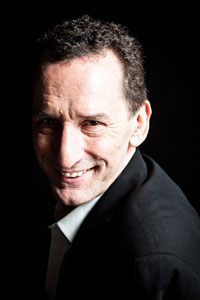 Gregg Goldston In 1975, Gregg Goldston saw a performance by Marcel Marceau and immediately began his pursuit of the art of mime. Mr. Goldston trained under Richmond Shepard in Hollywood. Four years later, he had written and produced three two-hour solo performances, opened his own mime studio, and began touring his show across America. In 1980, the Ohio Arts Council encouraged Mr. Goldston to relocate his Mime Foundation and School for Mimes to Ohio. In 1986, he created “The Invisible People,” a seven-member mime company that toured nationally and internationally until 1997. In 1980, he founded The Goldston School for Mimes Summer Intensive in Ohio. The School hosted five two-week Summer Seminars by the legendary Marcel Marceau, who stated to the press: “Goldston is creating the first generation of American Mimes.” Mr. Goldston was an Assistant Performer to Marcel Marceau during his USA tours (2002-04). In 2004, Goldston performed lead roles during a week of the final performances of the Marcel Marceau Nouvelle Compagnie de Mimodrame in America. Mr. Goldston opened his New York Mime Studio twenty years ago. In 2007, Mr. Goldston and Haruka Moriyama co-founded “The Funny Bones Mime Trio” for Lincoln Center's “Meet the Artist” Series and in 2014, co-authored “The History of Modern Mime.” His teaching and directing includes The American Ballet Theatre Summer Intensive 2006, Mime Coach for Anne Hathaway for the film: “Ella Enchanted,” and Mime Coach for Julie Harris for “Hanging Fire.” He created two short videos for the Sesame Street show as The Goldmime, titled K is for Kite and V is for Violin. In 2015, Mr. Goldston premiered his first full-length evening performance: “Weeping in Silence” at the 15th Annual Mime Art Festival in Warsaw. Mr. Goldston is working with Haruka Moriyama on “Weeping in Silence,” co-authoring a full-length company performance, “Sonatas of Love.” www.goldmime.com/
Gregg Goldston In 1975, Gregg Goldston saw a performance by Marcel Marceau and immediately began his pursuit of the art of mime. Mr. Goldston trained under Richmond Shepard in Hollywood. Four years later, he had written and produced three two-hour solo performances, opened his own mime studio, and began touring his show across America. In 1980, the Ohio Arts Council encouraged Mr. Goldston to relocate his Mime Foundation and School for Mimes to Ohio. In 1986, he created “The Invisible People,” a seven-member mime company that toured nationally and internationally until 1997. In 1980, he founded The Goldston School for Mimes Summer Intensive in Ohio. The School hosted five two-week Summer Seminars by the legendary Marcel Marceau, who stated to the press: “Goldston is creating the first generation of American Mimes.” Mr. Goldston was an Assistant Performer to Marcel Marceau during his USA tours (2002-04). In 2004, Goldston performed lead roles during a week of the final performances of the Marcel Marceau Nouvelle Compagnie de Mimodrame in America. Mr. Goldston opened his New York Mime Studio twenty years ago. In 2007, Mr. Goldston and Haruka Moriyama co-founded “The Funny Bones Mime Trio” for Lincoln Center's “Meet the Artist” Series and in 2014, co-authored “The History of Modern Mime.” His teaching and directing includes The American Ballet Theatre Summer Intensive 2006, Mime Coach for Anne Hathaway for the film: “Ella Enchanted,” and Mime Coach for Julie Harris for “Hanging Fire.” He created two short videos for the Sesame Street show as The Goldmime, titled K is for Kite and V is for Violin. In 2015, Mr. Goldston premiered his first full-length evening performance: “Weeping in Silence” at the 15th Annual Mime Art Festival in Warsaw. Mr. Goldston is working with Haruka Moriyama on “Weeping in Silence,” co-authoring a full-length company performance, “Sonatas of Love.” www.goldmime.com/























